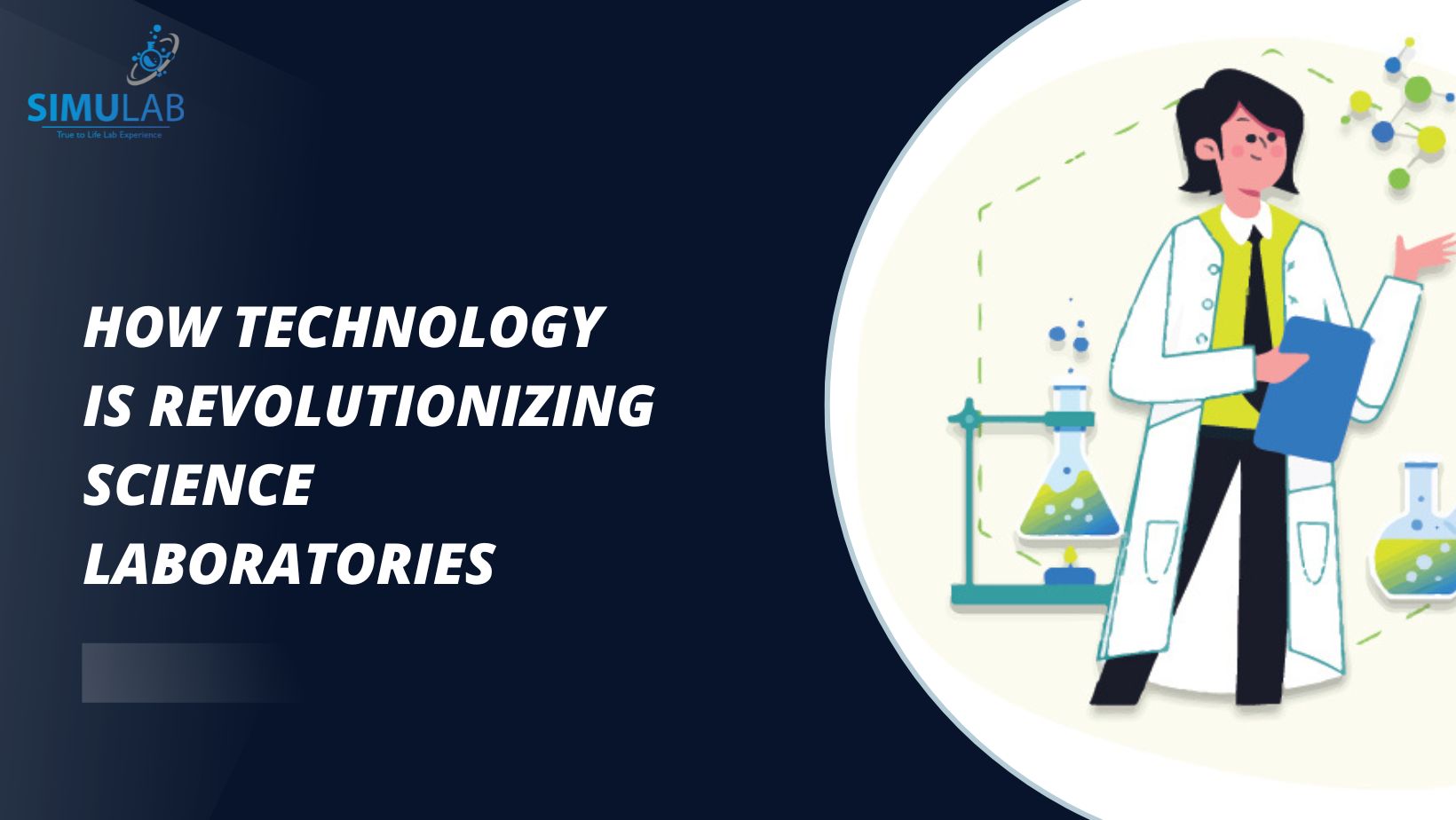In the world of science, laboratories have always been hubs of innovation and discovery, reminiscent of the futuristic settings portrayed in science fiction movies. Traditionally, these science laboratories were equipped with basic instruments, test tubes, and microscopes. However, an exciting transformation is underway, driven by cutting-edge technology.
In this blog, we’ll explore how technology, especially simulation-centric advancements like 3D games, virtual reality (VR), internet connectivity, 5G, DOM (Digital Object Modeling), and real-life experience-based tools, is revolutionizing science laboratories. Join us as we venture into the future of science, where virtual and real worlds converge to offer limitless opportunities for discovery and innovation in science laboratories.
Notably, these technologies also hold immense promise in education, enabling students to engage with science like never before in science laboratories. We’ll delve into how these innovations benefit education, making learning more immersive, accessible, and exciting.

The Rise of Simulation-Centric Laboratories
The rise of Simulation-Centric Laboratories represents a monumental shift in the landscape of scientific exploration. Traditionally, laboratories were equipped with physical instruments and tangible experiments, but today, they are at the forefront of a technological revolution. Simulation-centric laboratories are ushering in an era where researchers and students can engage with scientific concepts in immersive digital environments.
These laboratories are leveraging cutting-edge technologies, including 3D games, virtual reality (VR), robust internet connectivity, 5G networks, Digital Object Modeling (DOM), and real-life experience-based tools. These innovations are completely transforming the way experiments are performed, data is gathered, and knowledge is assimilated. They enable scientists to simulate complex scenarios, interact with virtual environments, and collect data in real-time.
In essence, simulation-centric laboratories are breaking down geographical barriers, enhancing accessibility, and making science education and research more engaging and interactive. They offer a glimpse into the future of science, where the line between the virtual and physical worlds seamlessly converges, creating limitless possibilities for discovery and innovation.
- 3D Games-Based Simulations
Envision a scenario where conducting intricate experiments in a digital realm closely resembles the complexities of reality, all within the secure confines of science laboratories. This is precisely what 3D games-based simulations offer. Through these simulations, both researchers and students can fully immerse themselves in virtual laboratory settings, replicating real-world scenarios with remarkable precision.
Within these simulated environments, they can engage in hands-on experiments, manipulate variables, and interact with objects, all within a meticulously detailed and highly realistic virtual landscape. This transformative technology doesn’t merely facilitate learning; it revolutionizes it.
Moreover, it encourages the exploration of intricate scientific concepts that might otherwise be challenging to grasp within traditional science laboratories. The interactive nature of 3D games-based simulations provides an unprecedented level of engagement, enabling learners to experiment, make mistakes, and learn from their experiences in a risk-free and dynamic digital laboratory environment. - Virtual Reality (VR)
Virtual reality (VR) has transcended its initial applications in entertainment and is now making substantial inroads into the world of science laboratories. This transformative technology allows scientists and students to transcend the boundaries of physical limitations and immerse themselves in virtual environments that authentically replicate real-world scenarios.
In this brave new world of VR-enhanced science, possibilities abound. Researchers can dissect virtual organisms with remarkable precision, conduct detailed examinations and analyse them as if they were handling real specimens. They can embark on interstellar journeys, exploring the vastness of distant planets, and experiencing the conditions on other celestial bodies firsthand.
The true power of VR technology lies in its unparalleled level of immersion and interactivity. It enables users to not only observe but actively engage with the virtual surroundings, fostering a deeper understanding of complex scientific concepts. VR is not just a tool; it’s a gateway to a new dimension of exploration and discovery within science laboratories, where the line between reality and the digital world continues to blur, expanding the horizons of scientific inquiry. - Internet Connectivity
In the contemporary landscape of science laboratories, the internet stands as an indispensable backbone, driving research and innovation to unprecedented heights. It has seamlessly woven itself into the fabric of scientific exploration, transforming the way researchers operate.
The internet, often referred to as the World Wide Web, serves as a gateway to an extensive reservoir of scientific literature and data. Researchers can effortlessly access vast databases brimming with scholarly articles, research papers, and historical records, all with just a few clicks. This instant access to the collective knowledge of the scientific community enhances the depth and breadth of research.
Moreover, the internet has dissolved geographical boundaries, enabling collaboration among researchers and scientists from every corner of the globe. Real-time communication tools, video conferencing, and collaborative platforms facilitate global cooperation on research projects. This interconnectedness has led to a fusion of diverse perspectives and expertise, accelerating the pace of discovery.
Internet connectivity has democratized access to knowledge, dismantling barriers that once hindered the pursuit of science. It has amplified the voices of aspiring scientists and expanded the reach of scientific findings. As a result, research has become more inclusive, collaborative, and efficient.
In essence, the internet is the catalyst that has streamlined the research process, fostering a dynamic and interconnected global scientific community. It is not just a tool; it is the lifeblood of modern science laboratories, propelling research and innovation to new horizons. - 5G Technology
The emergence of 5G technology has ushered in a transformative era for science laboratories, presenting a true game-changer in the pursuit of knowledge and discovery. With its lightning-fast speeds and ultra-low latency, 5G technology has unleashed a torrent of possibilities, revolutionizing the way scientific research is conducted.
At the heart of this technological leap is the capability for real-time data transmission. 5G’s blistering speeds facilitate the seamless transfer of massive datasets, enabling scientists to access and share information instantaneously. This not only expedites the research process but also enhances collaboration on a global scale.
One of 5G’s most remarkable contributions to science laboratories is its capacity for remote experimentation. Scientists can remotely control laboratory equipment from vast distances, bridging geographical gaps and transcending physical limitations. This capability opens up new frontiers in research, allowing experts to conduct experiments in remote or challenging environments with unparalleled precision and safety.
In essence, 5G technology is revolutionizing the research landscape, redefining the boundaries of scientific exploration, and fostering collaboration on an unprecedented scale. It empowers scientists to push the envelope of discovery, bringing us closer to unraveling the mysteries of the universe in science laboratories. - Digital Object Modeling (DOM)
Digital Object Modeling (DOM) is poised to revolutionize the landscape of data representation within science laboratories, catalyzing a paradigm shift in the way researchers approach experiments and analysis. This transformative technology empowers researchers to transcend the boundaries of the physical realm by crafting meticulous digital replicas of objects and organisms.
The applications are far-reaching. Scientists can construct digital replicas of everything from intricate biological organisms to complex mechanical systems, opening up a treasure trove of opportunities for in-depth analysis and experimentation. These digital counterparts allow researchers to manipulate variables, conduct simulations, and explore scenarios that might be challenging or even impossible to achieve in the physical world.
DOM’s true power lies in its capacity to enhance visualization and comprehension of complex scientific phenomena. Researchers can interact with these digital models in ways that were once unimaginable, gaining insights and understanding that would have otherwise remained elusive. It streamlines the research process, fosters a deeper understanding of scientific concepts, and accelerates the pace of discovery within science laboratories.
In essence, DOM is a cornerstone of the digital revolution sweeping through science laboratories, bridging the gap between the tangible and the digital. It empowers scientists to push the boundaries of knowledge, offering new avenues for exploration and innovation. - Real-Life Experience-Based Technologies
The realm of simulation extends far beyond the confines of traditional science laboratories, embracing a wide array of real-life experience-based technologies that are reshaping the landscape of scientific exploration. These innovative technologies empower scientists to venture into the heart of real-world scenarios while remaining within the controlled environments of their labs, fundamentally altering the way data is gathered and discoveries are made.
Consider, for instance, the ability to simulate the profound impacts of climate change on ecosystems. Researchers can immerse themselves in these digital recreations, exploring how rising temperatures, shifting weather patterns, and other environmental factors might reshape the intricate web of life on our planet. These simulations provide a valuable lens into the future of our world, offering insights into potential challenges and solutions.
These real-life experience-based technologies bridge the gap between theory and practice, offering scientists unprecedented opportunities for experimentation, observation, and analysis. They enable researchers to explore complex scenarios, test hypotheses, and gather data with a level of precision and control that was once unimaginable. In doing so, they empower science laboratories to be at the forefront of addressing critical global challenges and shaping a more sustainable and informed future.
Wrap-Up
The integration of simulation-centric technologies is ushering in a new era for science laboratories. Whether through 3D games-based simulations, virtual reality, internet connectivity, 5G, DOM, or real-life experience-based technologies, the boundaries of scientific exploration are expanding. These innovations are enhancing learning, facilitating collaboration, and pushing the boundaries of scientific discovery.
As we continue to embrace these technologies, the line between the virtual and real worlds in science laboratories will blur further. The future of science is an exciting blend of digital and physical exploration, where knowledge knows no bounds. Get ready to embark on this remarkable journey where technology transforms the very essence of science laboratories.
Writer – Subodh Dhruwaraj Choure
Technical Architect

